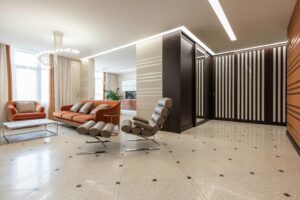
You may be wondering…what is a change of use?
A “Change of Use” is a formal process where you apply to convert a property from one legal planning use class to another, e.g. from commercial, retail, or office to residential.
This often applies to:
- Shops (Class E) are being turned into flats (Class C3)
- Offices converted to HMOs (House in Multiple Occupation)
- Pubs or banks transformed into apartments
Now, why does this matter?
Local Authorities control how land and buildings are used. A change of use requires planning consent to ensure the conversion is suitable, safe, and compliant with local and national policy.
Before you start, you need to know what the process involves
Before You Submit Your Planning Application…
You will be walked through the key steps that set the foundation for a successful conversion:
- Measured Survey We begin by capturing accurate dimensions of the existing building, giving us a solid base for design and planning.
- Feasibility Study We evaluate the viability of converting the space, looking closely at local restrictions like Conservation Area boundaries or Article 4 Directions.
- Concept Design Next, we craft layout options that not only meet national space standards but also comply with fire safety and Building Regulations.
- Planning Application Preparation We compile all the necessary documents—plans, reports, and design statements—and handle the submission process on your behalf.
Planning Phase
During the planning phase, the local authority reviews several key aspects:
- Design quality and overall layout
- Access arrangements and bin storage
- Amenity impacts, including noise, light, and ventilation
- Parking provision or wider transport implications
Public consultation and the officer review typically take around eight weeks. After this period, revisions to the proposal may be requested.
What Happens if Planning Is Refused?
If an application is rejected, the decision notice will outline the reasons. Possible next steps include:
- Amending the scheme and resubmitting the application
- Lodging an appeal against the refusal
- Exploring fallback options such as permitted development rights
Each route carries its own timeline, costs, and requirements, so the advice of a planning professional or advisor is often sought at this stage.
Common Complications
- Noise or odour concerns from adjacent uses
- Restrictions relating to listed buildings or conservation areas
- Limited external space or insufficient natural light
- Accessibility challenges or fire-escape constraints
Identifying and addressing these issues early—through careful design choices and, where appropriate, pre-application discussions—can help smooth the remainder of the planning process.
What are the benefits of converting property to residential?
- Increased rental yield – Residential use often generates higher ROI.
- Asset value uplift – Especially if the property is underused or vacant.
- Future-proofing – Residential demand is typically stronger and more stable.
Summary
At Studio Tashkeel, we bring planning strategy and design expertise together to deliver compliant, commercially driven residential conversions. Whether it’s a shop, warehouse, or office—we make change of use feel straightforward.
From first sketch to final consent.
Ready to launch your property conversion journey?
Do you have Plans in Mind? Let’s discuss the process and costs.
👉 Book a FREE 15-min Discovery Call
Connect with us:
🌐 Website
🔹 LinkedIn | Instagram | Facebook | Twitter
